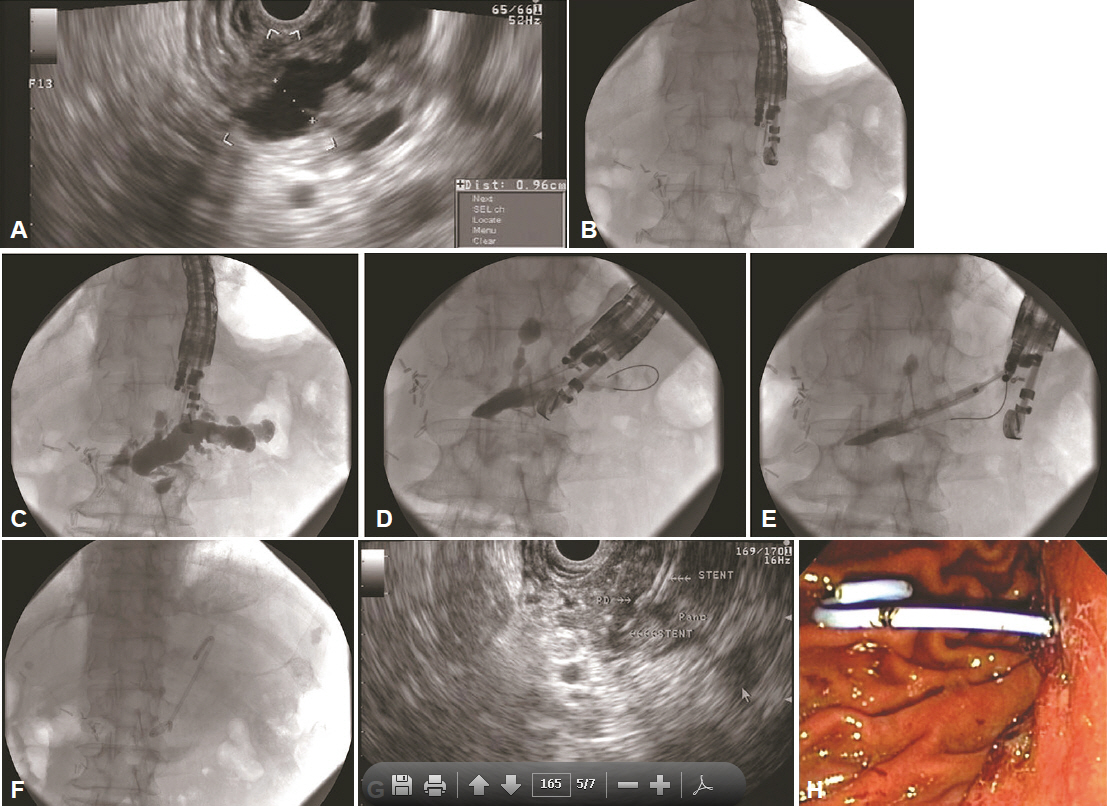Clin Endosc.
2016 Mar;49(2):161-167. 10.5946/ce.2016.011.
Endoscopic Ultrasound (EUS)-Guided Pancreatic Duct Drainage: The Basics of When and How to Perform EUS-Guided Pancreatic Duct Interventions
- Affiliations
-
- 1Center for Endoscopic Research and Therapeutics (CERT), University of Chicago Medicine, Chicago, IL, USA. usiddiqui@bsd.uchicago.edu
- KMID: 2165040
- DOI: http://doi.org/10.5946/ce.2016.011
Abstract
- Despite the advances in endoscopy, endoscopic ultrasound-guided pancreatic duct drainage (EUS-PDD) remains a technically challenging procedure. Technical success rates are greater than 70%; however, the average rate of adverse events is nearly 20%, which increases to 55% when stent migration is included. Until recently, a significant difficulty with this technique was the absence of dedicated devices. Proper patient selection is of utmost importance, and EUS-PDD should be reserved for patients who have failed endoscopic retrograde pancreatography. Furthermore, EUS-PDD must be performed by experienced endoscopists who are familiar with the technique. The most common indications include chronic pancreatitis induced strictures and stones, disconnected pancreatic ducts, inaccessible ampulla, and post-surgical altered anatomy. This manuscript will review the accessories used, techniques employed, and published literature reporting outcomes as well as adverse events regarding EUS-PDD.
MeSH Terms
Figure
Cited by 2 articles
-
Endoscopic Ultrasound-Guided Pancreatic Duct Drainage: Techniques and Literature Review of Transmural Stenting
Akira Imoto, Takeshi Ogura, Kazuhide Higuchi
Clin Endosc. 2020;53(5):525-534. doi: 10.5946/ce.2020.173.Endoscopic Ultrasound-Guided Pancreatic Duct Intervention
Yuto Shimamura, Jeffrey Mosko, Christopher Teshima, Gary R May
Clin Endosc. 2017;50(2):112-116. doi: 10.5946/ce.2017.046.
Reference
-
1. Dumonceau JM, Delhaye M, Tringali A, et al. Endoscopic treatment of chronic pancreatitis: European Society of Gastrointestinal Endoscopy (ESGE) Clinical Guideline. Endoscopy. 2012; 44:784–800.
Article2. Tessier G, Bories E, Arvanitakis M, et al. EUS-guided pancreatogastrostomy and pancreatobulbostomy for the treatment of pain in patients with pancreatic ductal dilatation inaccessible for transpapillary endoscopic therapy. Gastrointest Endosc. 2007; 65:233–241.
Article3. Ammann RW, Muench R, Otto R, Buehler H, Freiburghaus AU, Siegenthaler W. Evolution and regression of pancreatic calcification in chronic pancreatitis. A prospective long-term study of 107 patients. Gastroenterology. 1988; 95:1018–1028.4. Bakker OJ, van Baal MC, van Santvoort HC, et al. Endoscopic transpapillary stenting or conservative treatment for pancreatic fistulas in necrotizing pancreatitis: multicenter series and literature review. Ann Surg. 2011; 253:961–967.5. Brennan PM, Stefaniak T, Palmer KR, Parks RW. Endoscopic transpapillary stenting of pancreatic duct disruption. Dig Surg. 2006; 23:250–254.
Article6. Varadarajulu S, Noone TC, Tutuian R, Hawes RH, Cotton PB. Predictors of outcome in pancreatic duct disruption managed by endoscopic transpapillary stent placement. Gastrointest Endosc. 2005; 61:568–575.
Article7. Irani S, Gluck M, Ross A, et al. Resolving external pancreatic fistulas in patients with disconnected pancreatic duct syndrome: using rendezvous techniques to avoid surgery (with video). Gastrointest Endosc. 2012; 76:586–593.
Article8. Benage D, McHenry R, Hawes RH, O’Connor KW, Lehman GA. Minor papilla cannulation and dorsal ductography in pancreas divisum. Gastrointest Endosc. 1990; 36:553–557.
Article9. Bataille L, Deprez P. A new application for therapeutic EUS: main pancreatic duct drainage with a “pancreatic rendezvous technique”. Gastrointest Endosc. 2002; 55:740–743.
Article10. Amano H, Takada T, Ammori BJ, et al. Pancreatic duct patency after pancreaticogastrostomy: long-term follow-up study. Hepatogastroenterology. 1998; 45:2382–2387.11. Morgan KA, Fontenot BB, Harvey NR, Adams DB. Revision of anastomotic stenosis after pancreatic head resection for chronic pancreatitis: is it futile? HPB (Oxford). 2010; 12:211–216.
Article12. Reid-Lombardo KM, Ramos-De la Medina A, Thomsen K, Harmsen WS, Farnell MB. Long-term anastomotic complications after pancreaticoduodenectomy for benign diseases. J Gastrointest Surg. 2007; 11:1704–1711.
Article13. Takano S, Ito Y, Oishi H, et al. A retrospective analysis of 88 patients with pancreaticogastrostomy after pancreaticoduodenectomy. Hepatogastroenterology. 2000; 47:1454–1457.14. Kikuyama M, Itoi T, Ota Y, et al. Therapeutic endoscopy for stenotic pancreatodigestive tract anastomosis after pancreatoduodenectomy (with videos). Gastrointest Endosc. 2011; 73:376–382.
Article15. Kurihara T, Itoi T, Sofuni A, Itokawa F, Moriyasu F. Endoscopic ultrasonography-guided pancreatic duct drainage after failed endoscopic retrograde cholangiopancreatography in patients with malignant and benign pancreatic duct obstructions. Dig Endosc. 2013; 25 Suppl 2:109–116.
Article16. Kahaleh M, Hernandez AJ, Tokar J, Adams RB, Shami VM, Yeaton P. Interventional EUS-guided cholangiography: evaluation of a technique in evolution. Gastrointest Endosc. 2006; 64:52–59.
Article17. Mallery S, Matlock J, Freeman ML. EUS-guided rendezvous drainage of obstructed biliary and pancreatic ducts: report of 6 cases. Gastrointest Endosc. 2004; 59:100–107.
Article18. Itoi T, Kasuya K, Sofuni A, et al. Endoscopic ultrasonography-guided pancreatic duct access: techniques and literature review of pancreatography, transmural drainage and rendezvous techniques. Dig Endosc. 2013; 25:241–252.
Article19. Fujii LL, Topazian MD, Abu Dayyeh BK, et al. EUS-guided pancreatic duct intervention: outcomes of a single tertiary-care referral center experience. Gastrointest Endosc. 2013; 78:854–864.
Article20. Fujii-Lau LL, Levy MJ. Endoscopic ultrasound-guided pancreatic duct drainage. J Hepatobiliary Pancreat Sci. 2015; 22:51–57.
Article21. Giovannini M. EUS-guided pancreatic duct drainage: ready for prime time? Gastrointest Endosc. 2013; 78:865–867.
Article22. Itoi T, Sofuni A, Tsuchiya T, et al. Initial evaluation of a new plastic pancreatic duct stent for endoscopic ultrasonography-guided placement. Endoscopy. 2015; 47:462–465.
Article23. Oh D, Park do H, Cho MK, et al. Feasibility and safety of a fully covered self-expandable metal stent with antimigration properties for EUS-guided pancreatic duct drainage: early and midterm outcomes (with video). Gastrointest Endosc. 2016; 83:366–373.
Article24. Vila JJ, Pérez-Miranda M, Vazquez-Sequeiros E, et al. Initial experience with EUS-guided cholangiopancreatography for biliary and pancreatic duct drainage: a Spanish national survey. Gastrointest Endosc. 2012; 76:1133–1141.
Article25. Will U, Fueldner F, Thieme AK, et al. Transgastric pancreatography and EUS-guided drainage of the pancreatic duct. J Hepatobiliary Pancreat Surg. 2007; 14:377–382.
Article26. Ergun M, Aouattah T, Gillain C, Gigot JF, Hubert C, Deprez PH. Endoscopic ultrasound-guided transluminal drainage of pancreatic duct obstruction: long-term outcome. Endoscopy. 2011; 43:518–525.
Article
- Full Text Links
- Actions
-
Cited
- CITED
-
- Close
- Share
- Similar articles
-
- Technical tips for endoscopic ultrasound-guided pancreatic duct access and drainage
- Endoscopic Ultrasound-Guided Drainage of Pancreatic Fluid Collections (with Video)
- Forward viewing liner echoendoscopy for therapeutic interventions
- Endoscopic Ultrasound-Guided Pancreatic Transmural Stenting and Transmural Intervention
- Endoscopic Ultrasound-guided Drainage in Pancreatobiliary Diseases


